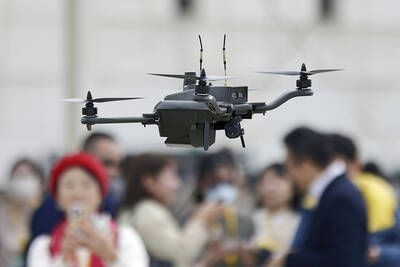China’s People’s Liberation Army Air Force could be on the brink of purchasing 48 Sukhoi 35 (Su-35) multirole air superiority fighters, in what has been described as one of the largest arms deals between the two countries in recent years.
A Russian Federation Ministry of Defence source told the Russian-language Kommersant business newspaper recently that the request for the Su-35s, made last year, was valued at more than US$4 billion, or about US$85 million per aircraft.
The two sides have “practically agreed” to the deal, the source said.
The Su-35 is a 4-plus-plus-generation multirole air superiority fighter that is just now entering service in the Russian Air Force, which has also ordered 48 in a deal that runs through 2015.
In addition to having some stealth and supercruise characteristics, the Su-35 is expected to be equipped with advanced passive electronically scanned array (PESA) radar systems.
The acquisition could further tip the balance of air power in the Taiwan Strait in China’s favor, as Taiwan remains unsuccessful in its requests to obtain 66 F-16C/Ds from the US, an aircraft that is almost a full generation behind the Su-35 (China’s J-20 and the US’ F-22 and F-35 are so-called fifth-generation aircraft).
However, fears of technological theft could add complexity to the Su-35 deal.
According to Jane’s Defence Weekly, Moscow has demanded guarantees that key technologies included in the aircraft — such as the PESA radar and engines — will not be reverse-engineered by China for export.
One official said Russia would only allow the deal to proceed if China purchased a minimum of 24 aircraft.
Last year, China canceled an order for 95 Su-27s for local assembly after Shenyang Aircraft Corp (瀋陽飛機) launched serial production of the J-11 fighter, which experts regard as a near copycat of the Su-27.
Meanwhile, China also reportedly requested an unspecified number of Almaz-Antei S-400 long-range air defense systems from Moscow in November 2010, hoping those could be delivered by 2015. However, Jane’s reported that production problems could make delivery impossible before 2017.
China already has more than a dozen Russian-made S-300PMU2 “Favorit” air defense systems in operation, which have a range of about 200km. About eight battalions, recently deployed in Fujian Province, could shoot down aircraft within some sectors of Taiwanese airspace. The S-400 has a range of approximately 400km, or about twice that of the US-made Patriot Advanced Capability 3 (PAC-3) system deployed by Taiwan.

The combined effect of the monsoon, the outer rim of Typhoon Fengshen and a low-pressure system is expected to bring significant rainfall this week to various parts of the nation, the Central Weather Administration (CWA) said. The heaviest rain is expected to occur today and tomorrow, with torrential rain expected in Keelung’s north coast, Yilan and the mountainous regions of Taipei and New Taipei City, the CWA said. Rivers could rise rapidly, and residents should stay away from riverbanks and avoid going to the mountains or engaging in water activities, it said. Scattered showers are expected today in central and

COOPERATION: Taiwan is aligning closely with US strategic objectives on various matters, including China’s rare earths restrictions, the Ministry of Foreign Affairs said Taiwan could deal with China’s tightened export controls on rare earth metals by turning to “urban mining,” a researcher said yesterday. Rare earth metals, which are used in semiconductors and other electronic components, could be recovered from industrial or electronic waste to reduce reliance on imports, National Cheng Kung University Department of Resources Engineering professor Lee Cheng-han (李政翰) said. Despite their name, rare earth elements are not actually rare — their abundance in the Earth’s crust is relatively high, but they are dispersed, making extraction and refining energy-intensive and environmentally damaging, he said, adding that many countries have opted to

FORCED LABOR: A US court listed three Taiwanese and nine firms based in Taiwan in its indictment, with eight of the companies registered at the same address Nine companies registered in Taiwan, as well as three Taiwanese, on Tuesday were named by the US Department of the Treasury’s Office of Foreign Assets Control (OFAC) as Specially Designated Nationals (SDNs) as a result of a US federal court indictment. The indictment unsealed at the federal court in Brooklyn, New York, said that Chen Zhi (陳志), a dual Cambodian-British national, is being indicted for fraud conspiracy, money laundering and overseeing Prince Holding Group’s forced-labor scam camps in Cambodia. At its peak, the company allegedly made US$30 million per day, court documents showed. The US government has seized Chen’s noncustodial wallet, which contains

SUPPLY CHAIN: Taiwan’s advantages in the drone industry include rapid production capacity that is independent of Chinese-made parts, the economic ministry said The Executive Yuan yesterday approved plans to invest NT$44.2 billion (US$1.44 billion) into domestic production of uncrewed aerial vehicles over the next six years, bringing Taiwan’s output value to more than NT$40 billion by 2030 and making the nation Asia’s democratic hub for the drone supply chain. The proposed budget has NT$33.8 billion in new allocations and NT$10.43 billion in existing funds, the Ministry of Economic Affairs said. Under the new development program, the public sector would purchase nearly 100,000 drones, of which 50,898 would be for civil and government use, while 48,750 would be for national defense, it said. The Ministry of